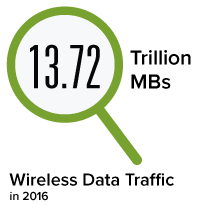Topics: Analytics & Reporting
 Did you know that 13.72 trillion MBs of data traffic were sent over wireless networks in America in 2016? The equivalent of 1.58 million years of streaming HD videos. That’s a lot of data. And for some businesses – a lot of work.
Did you know that 13.72 trillion MBs of data traffic were sent over wireless networks in America in 2016? The equivalent of 1.58 million years of streaming HD videos. That’s a lot of data. And for some businesses – a lot of work.
Today it’s common place for large enterprises to have hundreds or thousands of employees with mobile devices (or multiple devices), all with varying contracts, rate plans, features, etc. And it’s someone’s sole job to manage those mobile assets – how they’re assigned, being used, not being used, the resulting invoices, etc. – which is not an easy task.
The same goes for the mid-market and small business base. Although the device and data volumes decrease, so too do the resources to help manage, making it a tedious task for whomever draws the short end of the stick.
If managing mobile employees is such a nightmare, then why do the numbers continue to climb every year? Convenience.
Businesses know there is no alternative to the convenience that mobile services provide to their daily operations. And due to that, they’re willing to accept the frustration that comes with managing those assets. (It’s important to note that ‘accepting the frustration’ doesn’t mean they stop complaining about it to their suppliers).
What if you could alleviate that frustration and even turn it into a positive experience?
Through analysis of user-defined alerts and reporting, Globys Research has identified 3 key areas where business customers are applying real-time usage data and monitoring to simplify the management of their mobile assets:
We’ve all heard the horror stories of colossal data overages and similar to parents’ fears, employers are not naïve to the potential surprises associated with a mobile workforce. The creation of a corporate mobile policy is one thing – but the enforcement of that policy can take on a world of its own.
The challenge facing most businesses is they’re reacting to what’s already occurred (over and over again) and then struggling to find the level of detail required to isolate and address the problem. On the flip side, if they have constant visibility and a way to tie the usage to what’s relevant to their business, they can intervene when non-compliant usage first occurs.
To address this problem, business customers have created usage alerts aligned directly to their mobile compliance guidelines. Some specific examples include:
The chances of a customer’s business operations aligning perfectly with a supplier’s invoicing cycles are rare to none. This often creates an information gap mid-cycle. For example, if a company has recently deployed a new set of devices and wants to ensure they’re currently in use, they would have to wait a month or more to see those usage details through the invoice data. Same thing for other rolling changes such as implementation of new features, reallocated devices, deactivated devices, alignment to new policies, changes to data/voice pools, etc.
Users supplement their invoicing data with real-time usage data to analyze their needs – regardless of when the need for analysis arises. Did someone say the Sales Director needs to see where his sales reps were calling from last week? Done. And the CFO wants a report on international calls by end of day? Done.
Yes, you read that correctly. Sometimes the monitoring of wireless usage data doesn’t result in immediate action. But the visibility into what is occurring, versus what has already occurred, is often what businesses need to secure new devices, new services and ultimately, new spend.
If leadership is confident in the company’s ability to monitor usage – both efficiently and effectively – there’s a much higher chance for gaining spending approval. Users leverage the daily and weekly reports and visuals, covering all aspects of usage and non-rated costs, to consistently demonstrate how usage is tracking, how risks are being monitored, and how services can be optimized.
STAY TUNED for another post on ‘Real-time usage: What’s Important to Your Business Customers’, where we’ll continue to highlight the business drivers that are contributing to the successful adoption (and revenues) of the real-time usage component.
You can also attend the “Unlocking the Power of Usage Data” webinar on June 28 for a deeper dive on this series. This webinar will outline the solution to provide your customers with a near real-time view and 24×7 monitoring of their company’s utilization of your usage-based services, along with best practices and real world scenarios.
Get the latest in CSP B2B Portals delivered to your inbox.
